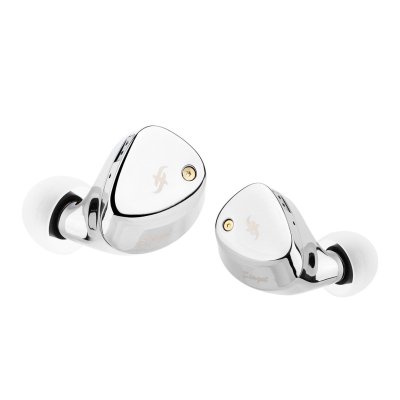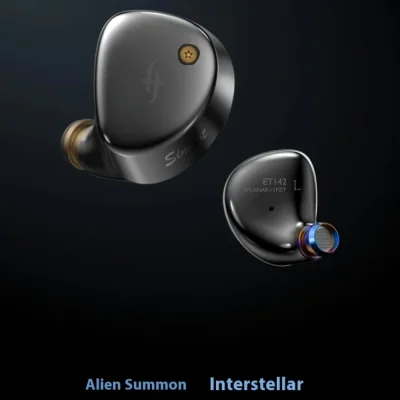Kiwi Ears Aether and Simgot ET142 use 1Planar and 1Planar+1BC driver setups respectively. Kiwi Ears Aether costs $170 while Simgot ET142 costs $220. Simgot ET142 is $50 more expensive. Simgot ET142 holds a slight 0.3-point edge in reviewer scores (7.3 vs 7.5). Simgot ET142 carries a user score of 7.3. Simgot ET142 has slightly better bass with a 0.3-point edge and Simgot ET142 has slightly better mids with a 0.4-point edge.
Insights
| Metric | Kiwi Ears Aether | Simgot ET142 |
|---|---|---|
| Bass | 7.1 | 7.4 |
| Mids | 7.4 | 7.8 |
| Treble | 7.4 | 7.6 |
| Details | 7.4 | 7.6 |
| Soundstage | 7.9 | 7.5 |
| Imaging | 7.9 | 7.5 |
| Dynamics | 6.8 | 7.5 |
| Tonality | 7.4 | 7.7 |
| Technicalities | 7.3 | 7.8 |
Kiwi Ears Aether Aggregated Review Score
Average Reviewer Scores
Average Reviewer Score:
7.3Generally Favorable
Simgot ET142 Aggregated Review Score
Average Reviewer Scores
Average Reviewer Score:
7.5Strongly Favorable
Reviews Comparison
Kiwi Ears Aether reviewed by Audio Amigo
Youtube Video Summary
Kiwi Ears Aether enters the crowded planar field at $170 with handsome resin shells, metal faceplates, and thoughtful venting that avoids pressure build-up. The unboxing looks premium but the accessories are plain—generic feeling 4-wire cable, basic case, and two tip sets—underwhelming for the price. Shells are on the large side yet surprisingly comfortable for long sessions and even pass the small-ears test, though very small ears may want a try-before-you-buy.
Sonically, Aether is a neutral-ish planar with a tasteful low-end lift: sub-bass has satisfying rumble without drifting into bass-head territory. The mids stay clean and natural, with female vocals slightly forward but not shouty, while the treble remains lively and detailed without tip-up glare or fatigue. Technical chops are solid—planar-typical speed and texture—with standout imaging and an expansive soundstage that elevates well-mastered tracks and comes surprisingly close to the big-shell staging specialists, all while remaining easy to drive.
In comparisons, Raptgo T10 Pro is warmer with better pack-ins but a smaller stage; Shuoer S12 Pro is more V-shaped with more sparkle, again out-accessorizing but not out-staging Aether. Hidizs MP45 still edges stage size, yet Aether delivers ~95–98% of that spaciousness with far better fit. Versus Tangzu x HBB Wu Heyday (discontinued) and the pricier Wan Legend, tuning is very similar, making Aether the stronger value under $200; Simgot EA42 can approximate the tonality with nozzle swaps but isn’t a direct competitor. Skip this if craving maximum bass/brightness or insisting on metal shells; for listeners wanting a balanced, spacious first planar—or a break from the usual V—Aether earns a confident This is brilliant verdict.
Audio Amigo Youtube Channel
Buy Kiwi Ears Aether on Linsoul
Ad
Price: $169
Buy Kiwi Ears Aether on Linsoul
Simgot ET142 reviewed by Audio Amigo
Youtube Video Summary
The Simgot ET142 is a $220 planar–piezo hybrid that arrives like a mini system: full-metal shells, the chunky but well-behaved LC7 modular cable (3.5/4.4 included), a sturdy magnetic case, and four tuning nozzles (titanium stock, gold, short black foam, short red foam). Build is solid and venting prevents pressure issues; finish is a fingerprint magnet and the shell+cable combo is heavy, comfortable for average ears but failing the “tiny ears” test in stock form. Accessory spread is excellent at the price, with multiple tip sets and spare O-rings/foams rounding out a thoughtful package.
Sonically, this is textbook planar bass: clean sub-bass rumble with punchy, textured mid-bass that doesn’t bleed. The midrange stays clear and unmasked, presenting busy mixes with ease, while vocal presence shifts with nozzle choice (short nozzles push fundamentals slightly forward). Treble is where the nozzles matter most: short red = relaxed and smooth; short black = balanced sparkle; titanium/gold = vivid, edging toward “hot” for treble-sensitive listeners. Technical chops impress—crisp microdetail from the PZT without harshness, precise imaging, strong separation, and a notably 3D soundstage. It’s also very easy to drive, playing happily from modest sources.
Think of ET142 as a three-in-one planar: titanium delivers a bright, energetic V-shape (S12/“classic planar” territory), short black dials it to a balanced, less aggressive profile (S12 Pro/2024 vibe), and short red shifts into the modern warm planar lane (akin to S15/S08). Compared with other nozzle-swap sets (e.g., Timeless 2), ET142 offers a wider tuning range up top, trading fine micro-timbre tweaks for genuinely distinct signatures. Caveats: none of the nozzles are truly neutral and the low end stays boosted, so lean-bass seekers should look elsewhere; the weight may be a deal-breaker for small ears. For anyone wanting a versatile planar that can swing from sparkly and fun to warm and relaxing with a quick nozzle swap, this earns a confident “you should buy this” recommendation on value and flexibility alone.
Audio Amigo Youtube Channel
Buy Simgot ET142 on Linsoul
Ad
Price: $219.99
Buy Simgot ET142 on Linsoul
Kiwi Ears Aether reviewed by Jays Audio
Youtube Video Summary
The Kiwi Ears Aether brings a balanced tuning with a thumpy, well-textured low end, clean vocals, and airy treble. Its large planar driver behaves with a DD-like timbre—more grounded than the typical light, floaty planar feel—so bass hits are punchy yet quick, with no bleed into the mids. Vocals sit naturally (neither shouty nor recessed), and the midrange reads clean and well-layered. Up top, extension and micro-detail are strong without fatigue; there’s a touch of extra sparkle that makes the set slightly brighter-leaning without turning sizzly.
As a mid-volume listen (~65 dB), Aether scales well: energetic K/J-pop or rock/metal with busy cymbals may ask for a notch down, while alt-pop, hip-hop, R&B, indie, and ballads benefit from the clarity and control. Versus smoother planars like Timeless 2, Aether trails slightly in sheer timbre naturalness but returns with a bit more treble detail and overall snap; compared with nozzle-tuned rivals, it threads a cleaner, better-extended middle ground. At around $170, its technical performance and planar bass that doesn’t sound planar make for compelling value—slotting neatly between bass-heavy and leaner sets, delivering texture, impact, and clarity without harshness. Recommended.
Jays Audio Youtube Channel
Simgot ET142 reviewed by Jays Audio
Youtube Video Summary
SIMGOT’s ET142 pairs a planar driver with a PZT, delivering a bright-leaning, lively all-rounder that feels like a more mature, slightly more detailed take on the original S12 tonality. Treble is the surprise: it carries bite and air without the usual planar “sizzle”, landing closer to a well-implemented PZT sheen. Micro-nuance on cymbal work is improved, vocals are open, and technical performance is among the best heard from planars in this bracket. The 2 kHz region can read a touch shy, while overall treble sits above Harman, so expect sparkle and energy rather than warmth.
Volume and fit matter. At mid levels (~60–65 dB) the ET142 sounds engaging and airy; push past ~70–75 dB and the upper energy can turn fatiguing, with forward vocals and sharper highs on busy tracks. Tip choice is critical: treble-boosting tips can be too much, whereas wide-bore, smoother tips (e.g., “Senai Wide”) keep the top end in check. Both included nozzles measure and sound essentially the same—an opportunity missed for a second, tamer tuning. Genre-wise, rock, indie and slower pop benefit from the speed and air; dense electronic can edge bright, while K-/J-pop stays bouncy at moderate volume.
Bass is quick, punchy and clean with tight decay and excellent separation—don’t expect DD-level rumble or lingering reverb, but do expect balance and definition. Versus safer, more relaxed tunings (S8/S15/S12 2024), the ET142 is the more exciting pick; against neutral all-rounders (e.g., “Pilgrim”), it trades smoothness for air and sparkle; compared to sets like “Dusk,” it’s livelier with less treble fizzle but a more forward top end. At around $200, build is excellent (metal shells, braided cable) and the value strong—competing with some $300–$400 options. In short: choose ET142 for a bright, technical, energetic listen; skip it if a laid-back or dark tilt is the goal.
Jays Audio Youtube Channel
Kiwi Ears Aether reviewed by Paul Wasabii
Youtube Video Summary
Kiwi Ears Aether debuts a 15.3 mm planar with a familiar bass shelf and extra ear-gain energy, followed by a gentle dip through 5–8 kHz. The result is clear, engaging vocals and lower fatigue, but a touch less perceived presence and technical bite versus top planar benchmarks like S12 2024. It stays in the learned zone for modern planars: natural, crisp enough, and largely free of distracting planar timbre.
Stock tuning is slightly sub-bass shy to preserve clarity alongside the relaxed lower treble, giving a safe, balanced listen that still sounds recognizably planar. The driver handles EQ confidently; a modest +1–2 dB lift in 5–8 kHz and a similar nudge to the bass restores edge, transparency, and punch without strain. Overall it reads as a safe planar choice—coherent and enjoyable out of the box, with headroom to become livelier for those who want more bite.
Paul Wasabii Youtube Channel
Simgot ET142 reviewed by Paul Wasabii
Youtube Video Summary
SIMGOT ET142 pairs a polished CNC metal shell with a comfortable ergonomic fit and the LC7 modular cable including 3.5 mm and 4.4 mm plugs plus a case. Four interchangeable nozzles are provided, with revised geometry in production rather than just foam stuffing, and the foam can be added or removed for fine-tuning. Build and accessories feel genuinely premium for the segment.
The original gold/blue nozzles target a brighter, analytical upper range; the new black sits in the middle with a smoother treble line, and red is the most restrictive and warmest. With black, ET142 tracks close to Letshuoer S12 2024 in balance but remains more relaxed up top with slightly less resolve; with red, the tonality leans toward a clean, dynamic-driver style that edges out Timeless 2's Gold Leaf for ease of listening. Swapping foam in or out yields small but useful shifts without breaking the core signature.
As a package, this set prioritizes tuning flexibility and ease of listening over chasing maximum air and extension. S12 2024 stays the single-planar reference for sheer end-to-end resolution, but ET142 answers with a best-in-class shell and cable and friendlier options for treble-sensitive ears. For those wanting planar technicalities with a smoother top end, the black and red nozzles form a compelling, configurable choice.
Paul Wasabii Youtube Channel
Kiwi Ears Aether reviewed by Z-Reviews
Youtube Video Summary
Kiwi Ears Aether hits with a 15.3 mm planar that feels more like a compact headphone than an IEM—big, airy, and unapologetically wide. Bass is unmistakably planar-fast with real sub-bass reach, while the top end adds a little sparkle without turning shouty. The midrange stays clean and clear, giving that “speaker-like” scale that makes Pink Floyd, Prodigy, or film scores feel expansive rather than congested.
Build and ergonomics lean large but smart: a roomy shell (no dreaded “wing of death”) that seems to help the staging, a tasteful stone-gray faceplate with pops of color, and a soft, flexible stock cable—nice, though it’s 3.5 mm only. Isolation is decent for a mostly closed design with discreet vents, and the set proves easy to drive, yet still scales audibly with a balanced cable and a solid source. Tip rolling shifts the flavor from relaxed and silky to a touch more forward; either way the presentation stays smooth, wide, and fast.
Value seals it: after guessing around $220 on sound and presentation, the real-world street price sits roughly in the ~$150–$170 bracket, making this an easy recommendation under $200. Aether stands out among planars for being big, relaxed, and immersive rather than in-your-face—great for music benders and late-night movies alike. Unique tuning, legit sub-bass, and that effortless planar snap put it firmly on the short list.
Z-Reviews Youtube Channel
Simgot ET142 reviewed by Z-Reviews
Youtube Video Summary
SIMGOT ET142 comes across as a sleek, chrome-heavy hybrid with a planar + PZT setup, dressed in CNC’d stainless shells and a surprisingly thick premium cable, plus a magnetic case and swappable 4.4/3.5 plug. Two tuning nozzles are included; differences are subtle, but the gold nozzles give a warmer, more relaxed balance versus the blued “airier” set. At a listed ~$220, the build and accessories feel upscale, though that cable is borderline overkill for an IEM.
On power, the ET142’s 14 Ω load behaves better with a more linear solid-state source (e.g., JDS Labs Element) than with tubes; an impedance adapter can tame noise. The tuning reads smooth, non-aggressive, with bass present but not the star; sub-bass “slam” isn’t the focus, yet vocals and staging are clean and pleasing. Treble with the gold nozzles stays polite, while the blued set adds some sparkle without turning harsh.
The special sauce is the imaging: sound feels “inside” and slightly behind the head, creating a quirky but engaging sense of placement that should be excellent for gaming. Overall it fits neatly among planar hybrids at this price—refined, smooth, and easy to enjoy rather than a fireworks show—earning a straightforward recommendation, especially for SIMGOT fans who value comfort, build, and that distinctive spatial presentation over brute-force bass.
Z-Reviews Youtube Channel
Kiwi Ears Aether reviewed by
 Fresh Reviews
Fresh Reviews
Youtube Video Summary
Kiwi Ears Aether lands as a standout at the $150 mark: a single large planar driver in a comfy, 3D-printed resin shell that can be worn for 8+ hours without fuss. The faceplate looks premium, the nozzle size is easy, and the sonic profile is smooth, clean, and engaging. Bass is punchy yet controlled—never bloated, never overly warm—while the stage sits in that gaming sweet spot: not too close, not too far. For music, it’s a crisp, non-fatiguing listen with clean mids and technical, tidy low end.
In games, Aether brings the goods: footsteps are elevated with urgency, imaging feels holographic (including vertical cues), and separation/layering remain intact when the action heats up—decisively clearer than Etude and Atheia. Across titles—CoD, Apex, Valorant, Siege, CS, Fortnite, Rivals—it consistently reads space and depth, only giving up a sliver of micro-detail in the densest, high-rank lobbies. That’s why it earns a B+ (borderline A-) on the WallHack Certified list. Astral at $300 still adds that last bit of clarity, but Aether is the top pick under $150; even compared to the Orchestra Lite, it’s similarly capable, more comfortable, and better value.
Fresh Reviews original ranking
Fresh Reviews Youtube Channel
Simgot ET142 reviewed by
 Fresh Reviews
Fresh Reviews
Youtube Video Summary
Build & accessories: ET142 arrives with an all-metal chassis, a tidy two-pin cable with interchangeable termination, and swappable nozzles (blue default vs. gold). The blue nozzle proves smoother, as the gold adds extra 2–3 kHz energy that can edge into shout. Ergonomics are compact, vented, and well-finished, though not as feather-light as some resin competitors.
Tuning & technicals: The hybrid architecture (planar plus bone-conduction) projects an expansive, airy stage with clean separation and layering. However, that upper-mid peak can make gunfire and busy mixes feel a bit spicy, leading to a “deer-in-headlights” sensation during chaotic moments. Tonally it’s clear and detailed, but the extra air sometimes pushes nearfield cues slightly forward in the stage instead of delivering immediate urgency.
Gaming performance: Imaging and verticality are solid and footstep cues are intelligible, placing ET142 in a B+ to B range for competitive play. Against a warmer rival with stronger low-end presence, ET142 is less fatiguing than the gold-nozzle setup but still brighter than ideal for Apex/Valorant chaos; the rival’s bass weighting keeps gunfire tamed and localization snappier. Overall, ET142 is good for gaming with strong separation and stage, best for players who value clarity and air over maximum urgency.
Fresh Reviews original ranking
Fresh Reviews Youtube ChannelKiwi Ears Aether (more reviews)
Kiwi Ears Aether reviewed by ATechReviews
Youtube Video Summary
The Kiwi Ears Aether comes in around 170 dollars as a planar IEM that delivers a surprisingly refined package: a compact zipper case, nine pairs of silicone tips in multiple firmness levels, and a soft 3.5 mm cable that stays tangle free and quiet in use. The resin shells with metal nozzle feel solid yet comfortable, with proper lip and generous venting so there is no pressure build up, while the sparkled faceplates give it a premium look. Out of the box the tuning leans toward a balanced, mildly V shaped signature with a natural tone that is clear, resolving and non fatiguing, setting the stage for what is positioned as a favorite planar IEM so far.
The low end focuses on quality over quantity, with a moderate but satisfying bass boost that is evenly split between sub bass and mid bass, tight and controlled with classic planar punch, speed and texture yet no bleed into the mids. The midrange sits in a sweet spot where it is neither shouty nor recessed, giving rock and metal the needed energy and clarity without harshness, and crucially avoiding the usual metallic planar timbre so instruments and vocals, especially female vocals, sound natural and full. Up top, the treble is airy, well extended and sparkly yet smooth, described as some of the best heard on a planar IEM, with crisp cymbals and hi hats, controlled S and SH sounds and an overall detailed but relaxed presentation that stays out of sibilant territory.
Technical performance is a major highlight: resolution, separation, imaging and layering are all excellent for the price, and the soundstage is notably wide and immersive for a planar, enhancing live and orchestral recordings in particular. The Aether also offers low distortion and generous EQ headroom, allowing a clean extra bass shelf without muddying the presentation, and in comparisons it is favored over sets like K4, Z12 or even the more expensive Timeless 2 for its more natural tonality, wider stage and easier treble. Recommended for listeners who want a highly detailed yet smooth planar with big stage and natural timbre rather than heavy bass slam, the Kiwi Ears Aether stands out as a top choice in this price range as long as extreme bass quantity is not the main priority.
ATechReviews Youtube Channel
Kiwi Ears Aether reviewed by Jaytiss
Youtube Video Summary
Kiwi Ears Aether arrives as a ~$170 planar with a classy, comfortable shell that seals well despite its larger size and visible venting. The accessories are familiar—typical Kiwi Ears case, okay tip selection—while the cable feels like a real upgrade: soft, pliable, and tidy with a solid 3.5 mm termination. Fit can be great, but smaller ears should note the chunkier housing.
Sonically, Aether leans neutral-bright with a clean midrange, airy treble, and standout micro-detail retrieval for the price. There’s adequate measured bass, yet the added brightness trims some perceived slam, so it’s not for bassheads. Compared with earlier Kiwi planars, it feels more tonally correct, carrying that planar crispness without the shout or glare that often trips sets up around the mid-treble.
In A/Bs, Aether trades blows with Aöso: the latter reads a touch better tuned, but Aether pulls ahead in technicalities—micro-nuances, textural cues, “whispers.” Melody is warmer but less accurate; S08 is darker and cheaper but less balanced; S12 variants push more 5–6 k energy; MP145 is impressive yet bulkier. Overall, Aether scores roughly an 8/10 with a clear note: choose it for a mid-focused, detailed presentation and excellent value in the planar field, skip it if the priority is big bass weight.
Jaytiss Youtube Channel
Kiwi Ears Aether reviewed by Gizaudio Axel
Gizaudio Axel original ranking
Gizaudio Axel Youtube ChannelKiwi Ears Aether reviewed by Super* Review
Youtube Video Summary
Think big planar energy: fast, deep sub-bass, a touch of sparkly treble, and a surprisingly speaker-like scale for a single 15.3 mm planar. The stage feels wide and “outside the head,” delivering that easy, expansive presentation without shoving details in the face. It’s the most relaxed-sounding planar IEM vibe—still quick and clean, but mellow enough to binge Pink Floyd, Prodigy, or movie soundtracks without fatigue.
The shells are huge yet comfy (no “wing of death”), with a gray stone-slab faceplate sprinkled in color and a metal rim—gorgeous in a low-key way. Stock cable is soft and usable but 3.5 mm only; thankfully it’s 2-pin, so a balanced swap wakes things up nicely. Isolation is decent despite a few vents, and the set proves easy to drive while still scaling with better sources. Packaging goes full silver overkill: neat tips selection and a pocketable case that does the job.
Value lands hard: street pricing around $150–170 makes this an under-$200 no-brainer for anyone craving planar speed with a big, airy, non-shouty presentation. The Aether stands out as unique in the planar crowd—wide yet fast, smooth yet detailed, with real sub-bass grunt—equally at home for late-night albums, action flicks, or a long flight.
Super* Review original ranking
Super* Review Youtube ChannelKiwi Ears Aether reviewed by Head-Fi.org
Kiwi Ears Aether reviewed by Web Search
The Kiwi Ears Aether is a single-planar IEM built around a large 15.3 mm planar magnetic driver, housed in a vented resin shell with 0.78 mm 2-pin connectors. Official specs list 14 Ω impedance and 105 dB/mW sensitivity, with an MSRP of $169.99—positioning it in the competitive mid-budget planar segment.
Tonally, the Aether targets a neutral with sub-bass lift presentation—Kiwi Ears describes a clean low-end, flat mids, and a natural treble rise for balanced monitoring. Independent listening reports broadly align, though some note the treble can become sharp at higher volumes depending on insertion depth and tips.
In practice, the Aether reaches usable volume from modest sources but shows better control and dynamics with a bit more power, consistent with many planars at this price. Ergonomically, the shell is on the larger side with a relatively shallow fit and venting, which can reduce isolation compared with sealed designs and may require tip-rolling for a stable seal; reports also highlight competitive imaging and stage once properly driven.
Kiwi Ears Aether Details
Driver Configuration: 1Planar
Tuning Type: Neutral with Bass Boost
Brand: Kiwi Ears Top Kiwi Ears IEMs
Price (Msrp): $169.99
Support our free service! Buying through our affiliate links costs you nothing extra:
Simgot ET142 Details
Driver Configuration: 1Planar+1BC
Tuning Type: V-Shaped
Brand: Simgot Top Simgot IEMs
Price (Msrp): $220
Support our free service! Buying through our affiliate links costs you nothing extra:
Kiwi Ears Aether User Review Score
Average User Scores
Average User Score: n/a
Based on 0 user reviews
No user reviews yet. Be the first one who writes a review!
Simgot ET142 User Review Score
Average User Scores
Average User Score:
Based on 1 user reviews
7.3Generally Favorable
Kiwi Ears Aether Gaming Score

Gaming Score & Grade
- The gaming score is prioritizing technical capabilities of the IEM (Separation, Layering, Soundstage) and good value.
Gaming Score
7.5Gaming Grade
ASimgot ET142 Gaming Score

Gaming Score & Grade
- The gaming score is prioritizing technical capabilities of the IEM (Separation, Layering, Soundstage) and good value.
Gaming Score
8Gaming Grade
A+Kiwi Ears Aether Scorings
Average Technical & Tuning Grades
Average Tunign Grade
A-- A smooth, agreeable balance keeps the presentation engaging without obvious flaws. Only sensitive ears will nitpick the bumps.
Average Technical Grade
A-- You get a controlled, composed performance, marrying decent clarity with a still-modest sense of space. A safe technical performer for the price bracket.
Simgot ET142 Scorings
Average Technical & Tuning Grades
Average Tunign Grade
A- Tuning feels well executed, keeping a natural flow across the spectrum. Switching genres feels seamless.
Average Technical Grade
A- The balance of resolution and space feels assured, keeping complex passages coherent. Layering is convincing on most studio mixes.
Kiwi Ears Aether User Reviews
"This is an example review"
Pros
- Example pro 1
- Example pro 2
Cons
- Example con 1
- Example con 2
Share your experience and build your personal ranking list.
You need to be signed in to write your own reviewSimgot ET142 User Reviews
Share your experience and build your personal ranking list.
You need to be signed in to write your own reviewThe Simgot ET142 delivers a smooth and natural sound signature with strong mids but lacks impact in the bass region.
Pros
Clear and detailed mids with good instrument separation; solid build quality and comfortable fit.Cons
Bass can feel a bit light for bassheads; soundstage is average and not very wide.Find your next IEM:
IEM Finder Quiz
newIEM Comparison Tool
newVS





























